You are here: Kim Dorland and the return to painting
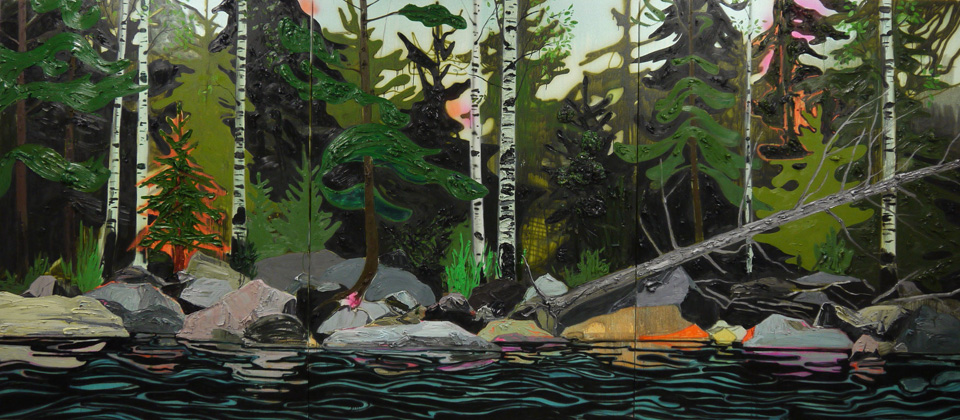 Kim Dorland, French River, 2013, oil and acrylic on jute over panel, each panel: 243.8 x 182.9 cm. Courtesy of the artist
Kim Dorland, French River, 2013, oil and acrylic on jute over panel, each panel: 243.8 x 182.9 cm. Courtesy of the artist
Rachel Weiner, who kindly guided me through the exhibition on a rainy Sunday afternoon, told me that the idea of showing Kim Dorland’s paintings among the Group of Seven’s came from chief curator Katerina Atanassova who initially approached Kim Dorland to exhibit at the McMichael Canadian Art Collection and offered him a residency.Dorland spent some time during his residency at the McMichael and at the memorial to the late Group of Seven painter, Tom Thompson, at Canoe Lake. It was a lucky thing that he paints quickly and was able to produce a rather large body of work. One of my favourite is Lost mother 2. I like the way the snow is three dimensionally painted and how the spray paint makes the homes and yards look like they are glowing with warmth amid the cold snowy scene.
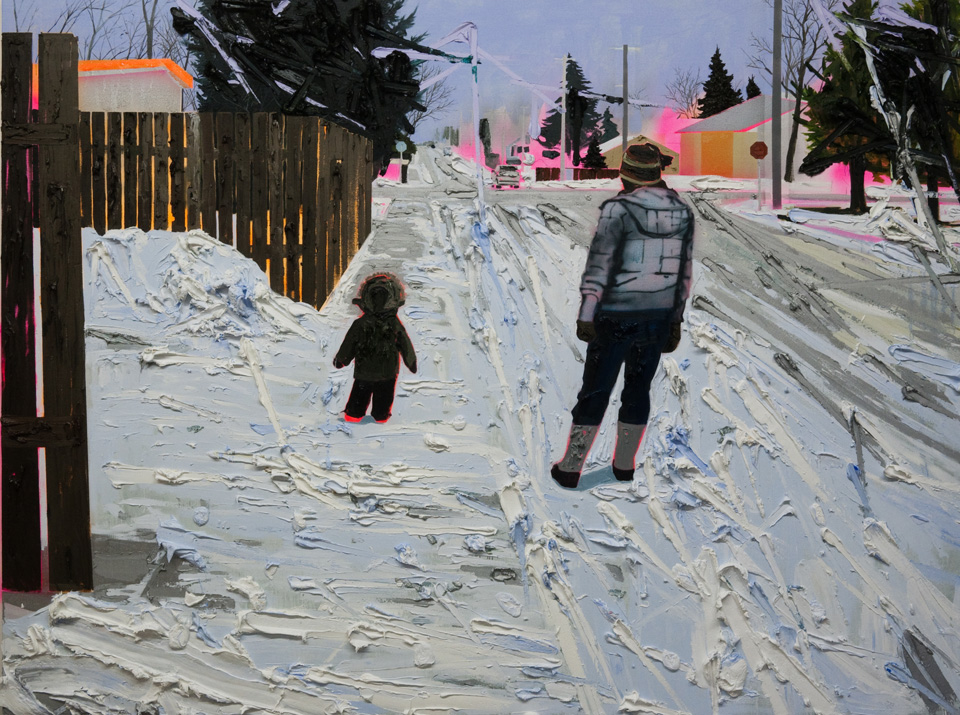 Kim Dorland, Lost mother, 2, 2012-13, oil and acrylic on jute, 180 x 240 cm. Courtesy of the artist.
Kim Dorland, Lost mother, 2, 2012-13, oil and acrylic on jute, 180 x 240 cm. Courtesy of the artist.
Dorland is not an outdoorsman. You can tell from his landscape paintings that he is uncomfortable in the woods. He is pictured in a self-portrait as wearing running shoes rather than hiking boots which is indicative of a city boy rather than a Plein Air painter who is comfortable in the Canadian forest. There is a horror movie look to some of the paintings as if Dorland is afraid to be there, in an unfriendly landscape surrounded by menacing black trees. Maybe his fear of his surrounding explains why his body radiates an unnatural energy of neon colours. Perhaps the running shoes afford the quick escape he is longing for.
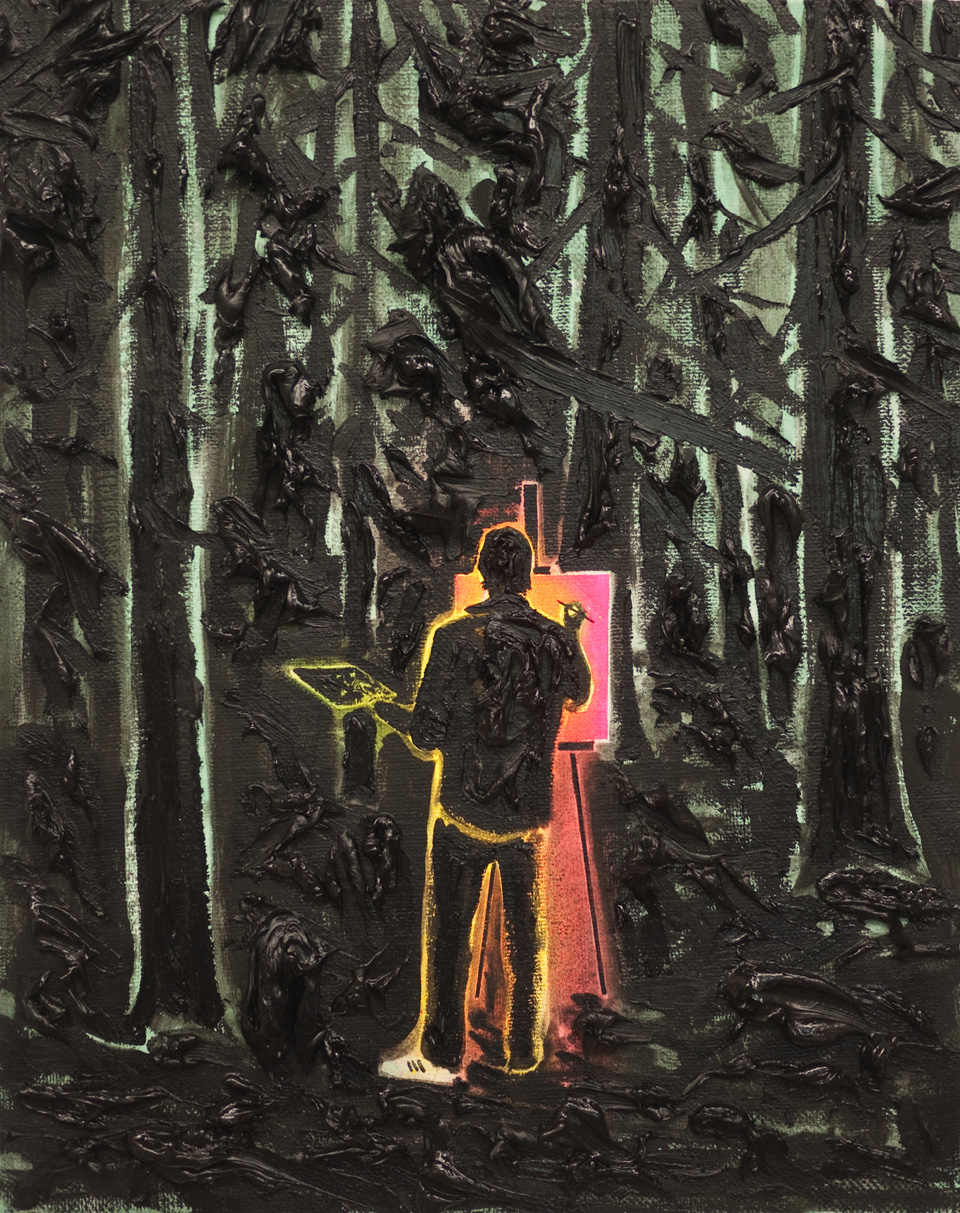 Kim Dorland, You Are Here, 2013, oil and acrylic on jute over wood panel, 50.8 x 40.6 cm. Courtesy of the artist
Kim Dorland, You Are Here, 2013, oil and acrylic on jute over wood panel, 50.8 x 40.6 cm. Courtesy of the artist
The show contains two of the walls of Kim Dorland’s studio complete with photos and sketches which were some of his inspiration and references for his paintings. A screen embedded in the wall shows a video shot out of a car window taken during a family road trip – mostly of forest.
There are several images of what was purported in the media to be Tom Thomson’s skull. He had been a lauded natural painting genius and outdoorsman who spent a lot of time canoeing and being a guide in Algonquin Park. After Thomson died on July 8, 1917, his body was found in Canoe Lake with damage to his skull. Rumors abounded at the time that he may have had an untimely death at the hand of a jealous husband or boyfriend as he was a known womanizer. Dorland’s portrait of Tom Thomson shows the late artist in profile. Rolls of paint cover his whole face, put on the surface straight from the tube, scrawling like maggots. The eye socket is a dark hole giving us the feeling that Dorland started with the skull and covered it with paint. The structure created in this way is very disturbing.
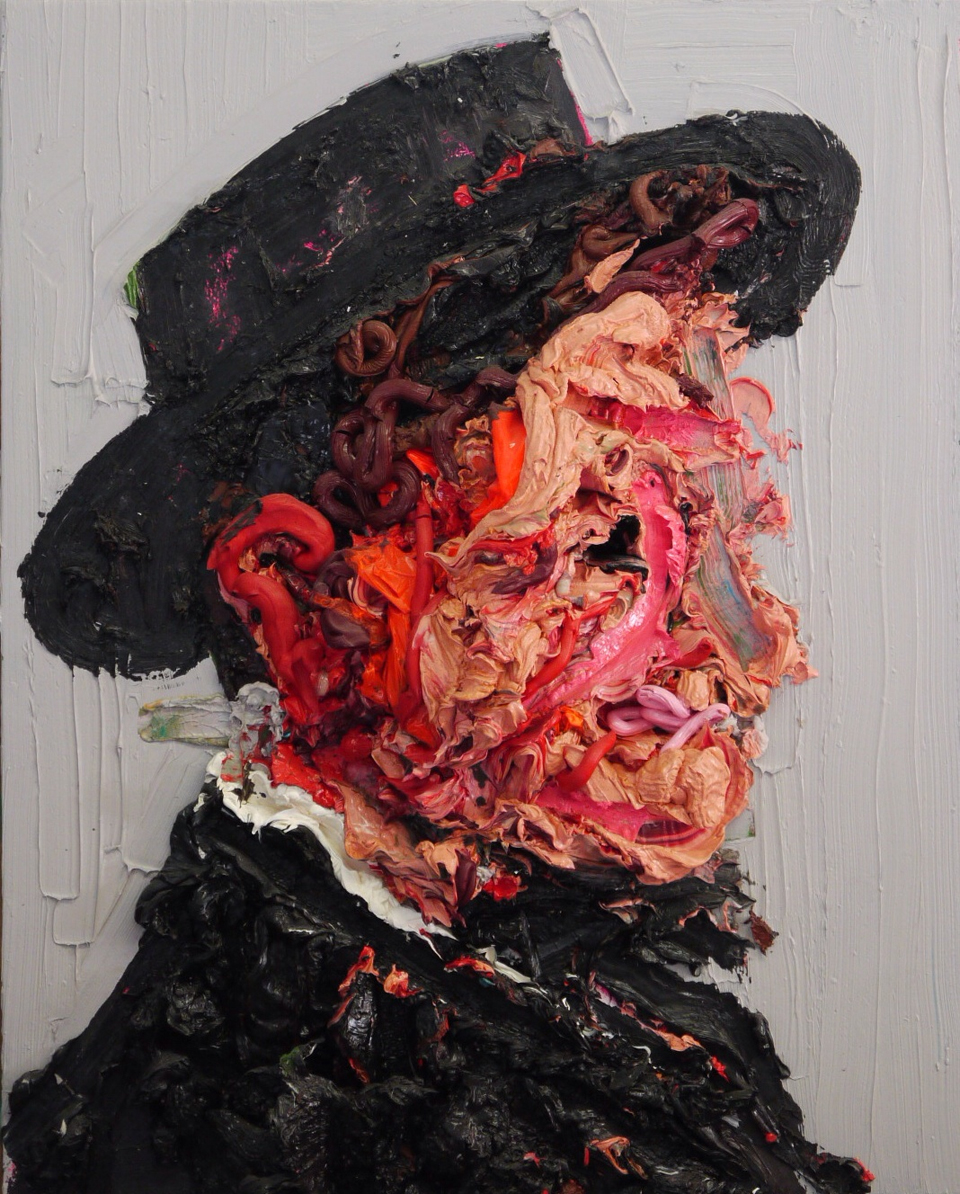 Kim Dorland, Portrait of Tom Thomson, 2013, oil and acrylic on wood panel, 50 x 40 cm inches. Courtesy of the artist.
Kim Dorland, Portrait of Tom Thomson, 2013, oil and acrylic on wood panel, 50 x 40 cm inches. Courtesy of the artist.
Some other portraits too have 3D paint sticking out in a sculptural fashion having almost a blood and guts appearance. People tend to either love it or hate it. Dorland builds up the paint until it feels like the model’s personal energy and considers them loving portraits of people, such as the one of his wife, Laurie. He wants to make it clear that these are paintings, not photographs, and purposely makes you notice the paint.
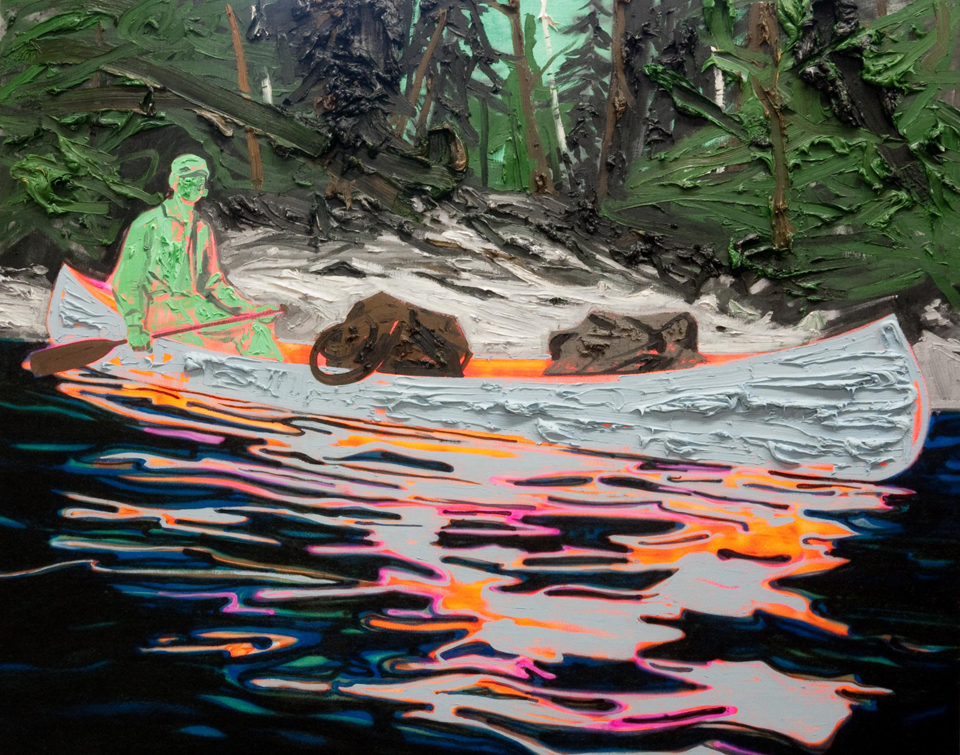 Kim Dorland, Untitled (Painter in a Canoe), 2013, oil and acrylic on jute over wood panel, 182.9 x 243.8 cm. The Bailey Collection.
Kim Dorland, Untitled (Painter in a Canoe), 2013, oil and acrylic on jute over wood panel, 182.9 x 243.8 cm. The Bailey Collection.
It is as much of an adventure for Kim Dorland to go to the woods to paint as it was for some members of the Group of Seven, except for Tom Thompson, who was more at home there. Dorland’s work is homage to the Group of Seven, but he doesn’t consider it as a continuation of their work. He wants it to be known that landscape painting can be part of contemporary art.
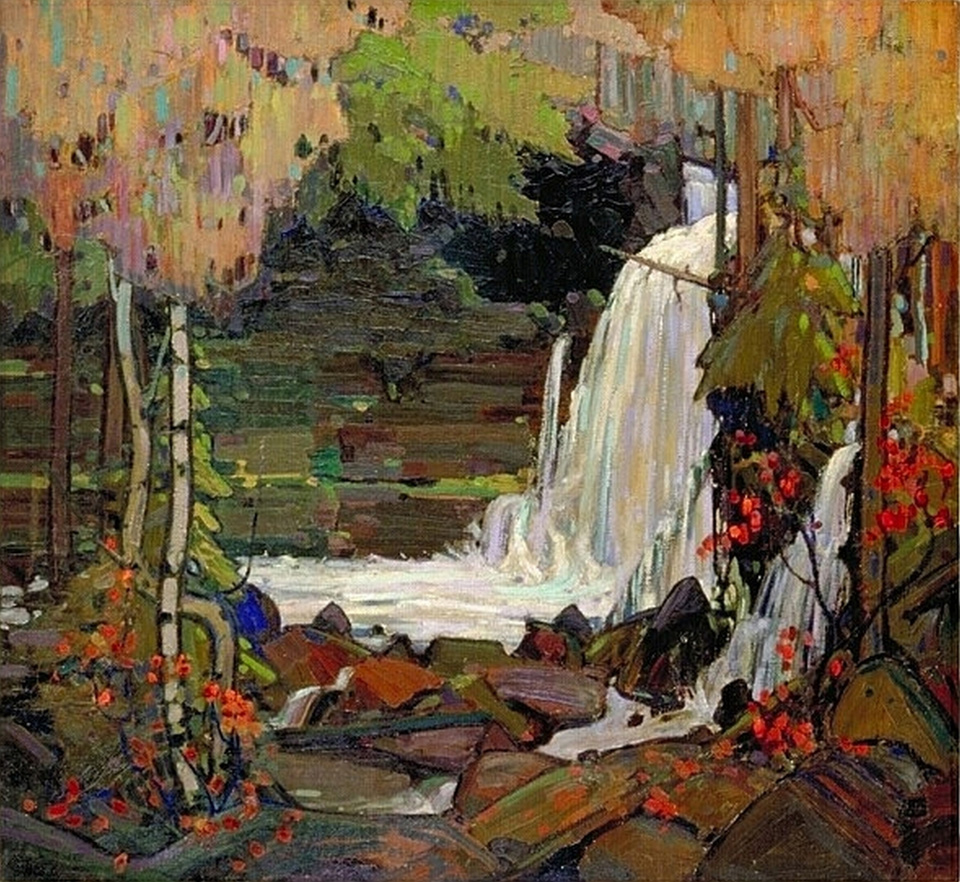 Tom Thomson (1877–1917), Woodland Waterfall, 1916–1917, oil on canvas, 121.9 x 132.5 cm. Purchase 1977 with Funds Donated by The W. Garfield Weston Foundation. McMichael Canadian Art Collection 1977.48
Tom Thomson (1877–1917), Woodland Waterfall, 1916–1917, oil on canvas, 121.9 x 132.5 cm. Purchase 1977 with Funds Donated by The W. Garfield Weston Foundation. McMichael Canadian Art Collection 1977.48
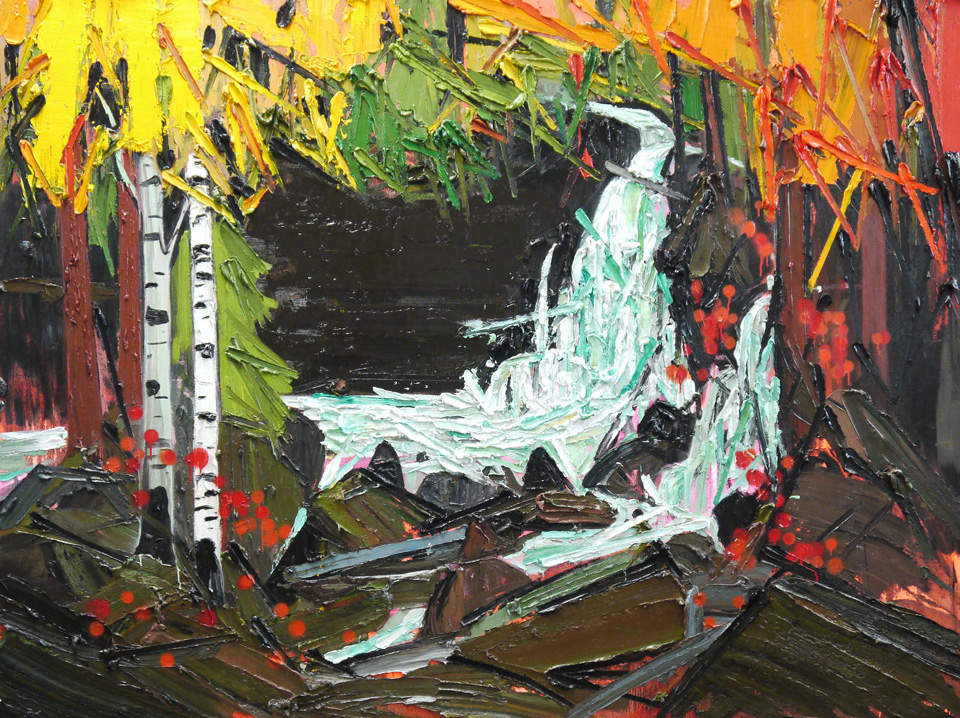 Kim Dorland, Woodland Waterfall (after Tom Thomson), 2013, oil, acrylic and spray paint on canvas over panel, 182.9 x 243.8 cm. Courtesy of the artist
Kim Dorland, Woodland Waterfall (after Tom Thomson), 2013, oil, acrylic and spray paint on canvas over panel, 182.9 x 243.8 cm. Courtesy of the artist
During his residency Dorland had access to the Group’s work for inspiration and could pick along with curator Katerina Atanassova any artworks that would be shown alongside his in the exhibition. The piece he chose to copy in his own style was Waterfall by Tom Thomson. The original painting is very soft and muted and of course Dorland’s is very vibrantly colored “rock and roll” style with a fearful, aggressive look and has spray painted elements. The original was classically painted with Golden Section design, so he has made a very unusual choice to paint in a modern style but as he said, he was interested in how people would respond to it.
Margaret Irving
*Exhibition dates: October 26, 2013 – January 5, 2014, McMichael Canadian Art Collection, 10365 Islington Avenue, Kleinburg, Ontario. Gallery hours: Tuesday to Sunday, 10 – 4 p.m. Open all holiday Mondays, closed December 25.
